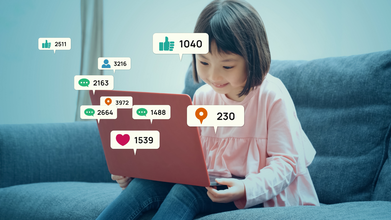- Health Conditions A-Z
- Health & Wellness
- Nutrition
- Fitness
- Health News
- Ayurveda
- Videos
- Medicine A-Z
- Parenting
New Mother’s Special: Learn About The Feeding Cycle Of Your Newborn

New Mother’s Special: Learn About The Feeding Cycle Of Your Newborn Credits: Freepik
Being a new mother can keep you thinking about your newborns, but the truth is your younger ones have tiny tummies which can result in frequent breastfeeding cycles. It is important to know that since breastmilk is digested quickly, a ‘demand-feeding’ pattern must be followed as it will ensure you as a mother that your baby is digesting and responding to meet their needs.
Properties of Breastmilk
Loaded with thousands of bioactive compounds, Breastmilk is an excellent source of energy and food for every newborn. Although newborns can only have breastmilk at their initial age, it is important to note that breastfeeding your child can not only help in developing the organs but also strengthen their immune system. Breastmilk contains essential proteins, lactose and fat which boost energy, growth and development in the baby.

Breastfeeding Time
As a new mother, you must have a lot of questions and concerns about your breastfeeding, but it is important to note that your newborn’s belly is really tiny and he/she doesn’t require a lot of milk at every feed. You can hear your baby swallowing and sucking which is a good sign. Your baby may demand feed every 1 to 3 hours and as your baby grows within weeks and months, their bellies will start developing and growing. Gradually, they’ll be able to drink more breast milk at every feed.
It is important to note that with growing bellies, your baby’s feed schedules will get longer. Every baby has a different feeding cycle, some babies might demand milk every hour or many can go on for 4-5 hours without feed. Newborns will breastfeed about 9 to 12 times a day.
Mothers often breastfeed their kids for a year. It is recommended to continue breastfeeding even after your baby seems less interested after you introduce solid foods in their diet. Breastmilk is an essential source of nutrition and will benefit your child's growth and development even after your baby is feeding on solid foods.
Note: In the initial days, your baby will take some time to practice swallowing and sucking. Frequent breastfeeding will elevate your milk supply.
Breastmilk and formula difference
Breastmilk is the powerhouse of nutrients and essential sources which is considered extremely beneficial in your baby’s growth and development. On the other hand, the formula lacks antibodies. This method can’t provide enough nutrients and a protection shield to your baby which can help in fighting against the illnesses.
Many mothers switch to combination feeding wherein the baby is fed by both breastmilk and infant formula. According to the studies, breastmilk is considered an ideal choice for the newborns.
What is the right time to move onto semi-solids?
The babies are introduced to the world of semi-solid foods around 6 months of age. In this stage, your baby requires more energy and nutrients which can’t be fulfilled solely by breastmilk. It is important to note that incorporating soft foods like porridge, mashed vegetables and fruits, twice a day can be a great addition to your baby’s diet.
Australia Social Media Ban Explained: Why Government Plans to Restrict Accounts of Under-16s

Credits: iStock
Anyone below the age of 16 in Australia is now banned from using social media services. These platforms include TikTok, X, Facebook, Instagram, YouTube, Snapchat and Threads. The law now says that anyone under 16 cannot make new social media accounts and their existing accounts will be deactivated. This is the first of its kind banned and is also being watched by other countries.
What Is The Reason Behind The Under-16 Social Media Ban?
To protect the mental health of children is the main reason behind the ban. Furthermore, the government says that it will also reduce the negative impact of social media's "design features that encourage [young people] to spend more time on screens, while also serving up content that can harm their health and wellbeing". A government study which was commissioned in 2025 found that 96% of children aged 10 to 15 used social media, and that seven out of 10 of them were exposed to harmful content. These content were misogynistic and violent in its nature, furthermore, content promoted eating disorders and suicide.
Read: AI Therapy Gone Wrong: Psychiatrist Reveals How Chatbots Are Failing Vulnerable Teens
1 in 7 also reported experiencing grooming-type behavior from adults or older children. More than half said that they were also victim of cyberbullying. The ban right now expands over platforms and apps like Facebook, Instagram, Snapchat, Threads, TikTok, X, YouTube, Reddit, and streaming platforms Kick and Twitch.
The government laid down three categories, under which the ban has been considered for the apps, these criteria are:
- whether the platform’s primary or substantial purpose is to enable online social interaction between two or more users
- whether users can interact with some or all other users on the platform
- whether users are able to post or share content
YouTube Kids, Google Classroom and WhatsApp are not covered under this rule as they do not fit those criteria. While anyone under 16 will be still able to watch most of the content without logging in, however, they cannot have an account on it. Critics are urging the government to widen the ban to include online gaming platforms such as Roblox and Discord, which are currently not covered.
Also Read: Why Social Media Trends Could Be Detrimental To Your Health?
Are There Any Checks And Balances On The Ban?
The law notes that children and parents will not be punished for infringing the ban, instead, social media companies will face fines of up to A$49.5m, which is equivalent of US$32m for serious or repeated breaches. The government has said that these companies must take 'reasonable steps' to keep kids off the platforms. These 'reasonable steps' include asking for government IDs, face or voice, or "age interference" that analyzes online behavior and interactions to estimate a person's age. Platforms have been advised against relying on users self-certifying or parents vouching for their children. Meta, which own Facebook, Instagram and Threads have started to close teen accounts from December 4 onwards. Snapchat will also be using bank account, photo ID or selfies for verification.
However, government reports have found facial assessment technology to be least reliable for teenagers. Some critics have also raised their concerns on potential fines. Some have also pointed out other platforms which involves gaming platforms, or AI chatbots that have encouraged children to kill themselves and indulged in 'sensual' conversations with minors.
Zen Birth: Why Mothers Are Now Choosing This Over Delivery Rooms

Credits: iStock
For generations, childbirth has been closely tied to a certain visual and emotional script. Bright lights, clinical beds, beeping monitors, and an air of urgency have long defined labor rooms. Today, that script is being rewritten. Across hospitals and birthing centers, childbirth is undergoing a quiet but powerful aesthetic shift, one that places calm, comfort, and emotional safety at the center of the experience.
At the heart of this transformation is the growing popularity of warm water births and thoughtfully designed birthing spaces. As Dr. Preety Aggarwal, Medical Director of Obstetrics and Gynecology at Motherhood Hospitals, Gurugram explains, “From harsh hospital lights to calm, spa-like spaces, childbirth is being reimagined as a peaceful, deeply personal experience wherein tranquility takes center stage over tension.” What once felt intimidating is increasingly being shaped to feel intimate and reassuring.
From Medical Event to Life Experience
Childbirth has always been transformative, but for decades, the setting often heightened fear rather than eased it. Labor rooms were designed primarily for efficiency and medical control, not for emotional comfort. That approach is now evolving. More couples are actively seeking environments that respect birth as both a physiological and emotional journey.
“Childbirth is a one-of-a-kind experience. It is deeply transforming for the mother,” the doctor notes. This understanding has prompted hospitals to rethink how birthing spaces look and feel. Neutral colous, warm lighting, wooden textures, and minimal visual clutter are replacing stark whites and harsh fluorescents. The goal is not to eliminate medical safety, but to soften its visual dominance.
The rise of warm water birthing pools fits naturally into this shift. These pools are often placed in private, dimly lit rooms that resemble wellness studios rather than hospital wards. Gentle music, controlled lighting, and calming scents further enhance the sense of control and peace.
Why Warm Water Changes the Experience of Birth
Water has an innate ability to soothe. Immersion in warm water relaxes muscles, reduces physical tension, and encourages slower, deeper breathing. According to clinical observations, many women feel a stronger sense of control when laboring in water. The pool acts as a physical and psychological buffer, helping block out noise, distractions, and external stress.
The expert points out that water births are not only about comfort but also about reducing fear. Many mothers report feeling less anxious and more connected to their bodies during labor. This inward focus can make contractions feel more manageable and the overall experience more empowering.
Rephrasing this idea, the essence of water birth lies in its ability to support the body’s natural rhythm. Instead of fighting pain, women are encouraged to work with it, supported by warmth, buoyancy, and privacy.
Aesthetic Calm with Clinical Safety
One of the most common misconceptions about serene birthing environments is that they compromise safety. In reality, the shift is about balance. Modern birthing spaces are designed to keep medical equipment accessible but discreet. The focus is on emotional well-being alongside clinical readiness.
“There is a clear shift in attitude,” the doctor explains, adding that childbirth is no longer seen as just a medical event but as a life experience deserving emotional care. This change also reflects broader conversations around respectful maternity care, where the mother’s comfort, dignity, and choices are prioritized.
Creating a Zen Birth Experience
For expectant parents interested in this approach, preparation plays a key role. Choosing a hospital or birthing center that offers warm water birth options and calming room designs is the first step. Simple additions like soft lighting, calming music, and guided breathing techniques can make a noticeable difference.
Incorporating natural elements such as plants and warm colors helps create a grounding environment. Emotional support from a partner, doula, or trusted caregiver is equally important. A clear birth plan that balances comfort preferences with medical safety allows both parents and healthcare teams to work in harmony.
Redefining How Birth Feels
Warm water pools and serene birthing environments are changing more than the appearance of labor rooms. They are reshaping how birth is felt, remembered, and processed. By replacing tension with tranquility, this approach supports mothers in feeling calmer, more confident, and more present during one of life’s most intense moments.
As the expert advises, anyone considering this option should discuss it with their doctor and make informed decisions based on individual health needs. What is clear, however, is that the aesthetics of childbirth are no longer an afterthought. They are becoming an essential part of how birth itself is experienced, marking a meaningful shift toward gentler, more human-centered care.
What Is Denmark's 'Cry It Out' Method Of Putting Babies to Sleep?

Credits: iStock
Sleep training is a key to a good night's rest. This is especially true for the parents who are still new with handling their babies. One such method of sleep training, famous in Denmark is called the 'cry it out' method.
However, this method has been long in debates, Especially with one side saying that allowing babies to bawl does no harm, whereas, other sets of research and studies suggest that it impacts babies' emotional quotient. In fact, research suggest that leaving the babies to cry could have knock-on effects including damaging the bond between parent and child and raising the infant's stress levels.
However, recently, 723 Danish psychologists signed an open letter stating that cry it out sleep method, known as the "good night and sleep well" method in Denmark should be discouraged, as such methods may risk the attachment and child's development.
What Exactly Is The 'Cry It Out' Method?
This is also known as the extinction method, where rather than answering your little one's crying call as soon as it goes out, you give them the opportunity to independently work it out and nod off. This method is not intended to be cruel, it is meant to be used as an intentional tool to teach your baby self-soothing techniques that will stick with them for life.
Some also call it same as going cold turkey on your child. Parenting experts say that you put your baby in their crib, say goodnight and shut the door.
The Debate Of Those In Favor Of Cry It Out And Those Against It
A study led by researchers from the University of Warwick and published in the Journal of Child Psychology and Psychiatry, followed 178 babies and their mothers in the UK from birth to 18 months. Mothers regularly filled out questionnaires explaining how often they let their baby “cry it out” shortly after birth, and again at three, six, and 18 months.
Researchers also observed mother-infant interactions through video recordings at three and 18 months. At 18 months, they assessed children’s behavior and attachment using parent questionnaires, psychologist reports, and observations of play.
The results showed that most mothers rarely let newborns cry. However, by 18 months, around two-thirds allowed their child to cry sometimes or often. Importantly, babies who were occasionally allowed to cry as newborns tended to cry for shorter periods by 18 months.
No Clear Evidence of Harm
The team found no negative effects on the child’s emotional attachment, behaviour, or the mother’s sensitivity by 18 months. Based on these findings, researchers concluded that the practice does not appear to cause harm.
Professor Dieter Wolke, a co-author of the study, said parents may have worried unnecessarily about the issue. He suggested that debates around crying may have been exaggerated.
The Ones Against The Cry It Out Method
Not everyone agrees that the findings settle the debate. Professor Amy Brown from Swansea University, who was not involved in the research, warned that the results should be interpreted carefully. She noted that very few mothers in the study regularly used the “cry it out” approach, and the study did not examine how long babies were left to cry or how distressing parents found the experience.
She also emphasized that the research does not prove controlled crying is beneficial, nor does it address the emotional toll it can take on caregivers.
The Developing Infant Brain
Some researchers highlight concerns about stress in early life. A baby’s brain grows rapidly in the first year, and intense distress triggers the release of cortisol, a stress hormone. In high levels, cortisol may harm developing neural connections. While the effects may not be immediate, some experts question whether repeated distress could have long-term consequences.
Stress, Self-Regulation, and Trust
Infants rely on caregivers to learn how to regulate emotions. When caregivers respond quickly and consistently, babies learn calmness and trust. Comforting a distressed baby helps build the foundation for self-soothing later in life.
Critics argue that leaving babies to cry may teach them to shut down emotionally rather than truly self-regulate. Over time, this could affect how children respond to stress and relationships.
The Role of Caregiver Responsiveness
Decades of developmental research show that caregiver responsiveness plays a crucial role in positive outcomes such as emotional regulation, social skills, empathy, and even intelligence. When caregivers are sensitive to a baby’s signals, it supports healthy brain and emotional development.
Because responsiveness is so influential, experts stress that any parenting approach should prioritize attentiveness to a child’s needs. While occasional crying may not be harmful, consistent care and emotional availability remain central to healthy development.
© 2024 Bennett, Coleman & Company Limited

